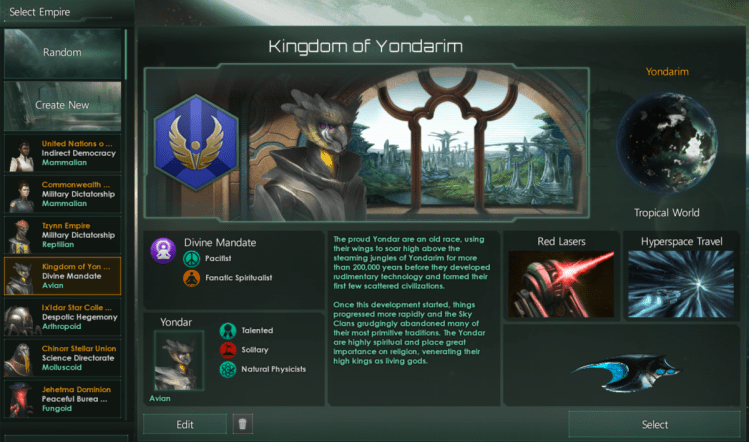Stellaris’ biggest strength doesn’t appear to be its beautiful graphics, its expansive universe, its seemingly endless variety, or its fun pace of gameplay as you explore and build out and conquer your galaxy.
Its menus take that prize.
Paradox Interactive has built a reputation for thorny, twisty, impossibly complicated grand strategy games, such as Europa Universalis and Crusader Kings. The sim Cities: Skylines, from the appropriately named developer Colossal Order, was its most accessible release in years.
So when I heard Paradox was venturing into space with Stellaris and that your universe could host a thousand star systems, each with its own planets and factions and archaeology and tech and … I took a deep breath before I buckled down to play. I didn’t need to worry; Stellaris immediately surprised me.
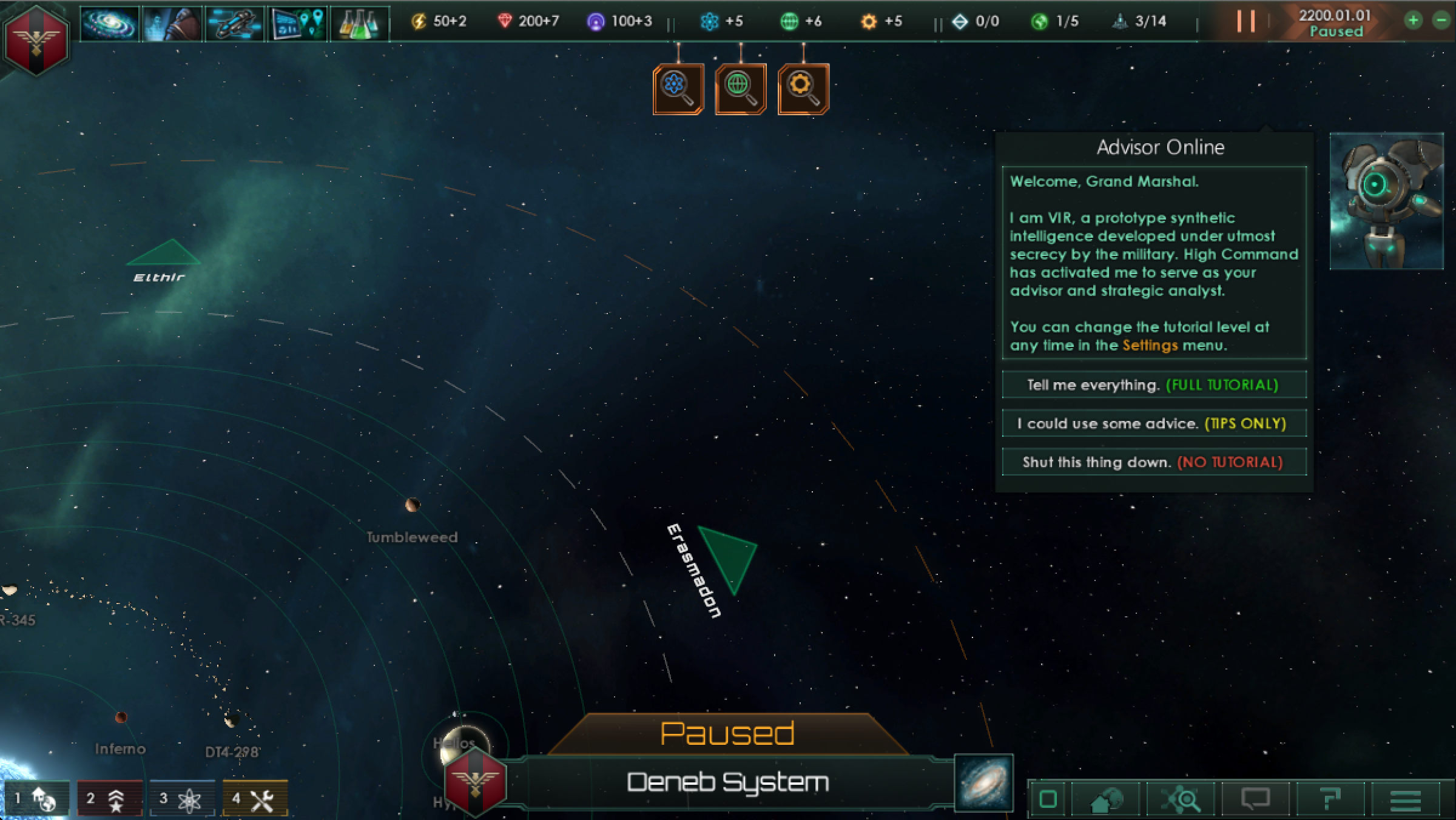
Above: A truly helpful tutorial walks beginners through the steps of using Stellaris using a variety of fun quests.
What you’ll like (so far)
A grand strategy game that makes it easy for you to manage
First, my bias: Given a choice between a standard 4X strategy game that invites you to eXplore, eXpand, eXploit, and eXterminate, and a grand strategy title that forces you to micromanage a thousand different sliders and activities and diplomatic relations and acquisition of a gajillion materials, all as part of a grand plan to take over something, somewhere, I tend to lean toward the former.
I like the “you’re starting from scratch” feel of most 4X titles and the feeling that if your strategy sucks, it’s all short term — making it easy to redirect and get back on track. But after playing through more than 50 hours of Stellaris, I’m starting to think my complaint with earlier grand strategy games didn’t stem from their finicky, thoughtful nature. It came from their user interface.
This game makes it easy — fun, even — to keep track of what’s going on. A handy “outliner” menu at the side of the screen makes it helps you zip to where the action is, and the screens that track what you’re doing in different locations show obvious thought and intentional design.
In a game where clicky-clicky forms the heart of the real-time gameplay, it felt completely refreshing for my little command cockpit to feel so intuitive, easy to navigate, and pretty to look at. It was like settling into the pilot’s seat of a luxury jet and realizing that I immediately knew all the controls, with everything placed in easy reach and chromed to make it pretty.
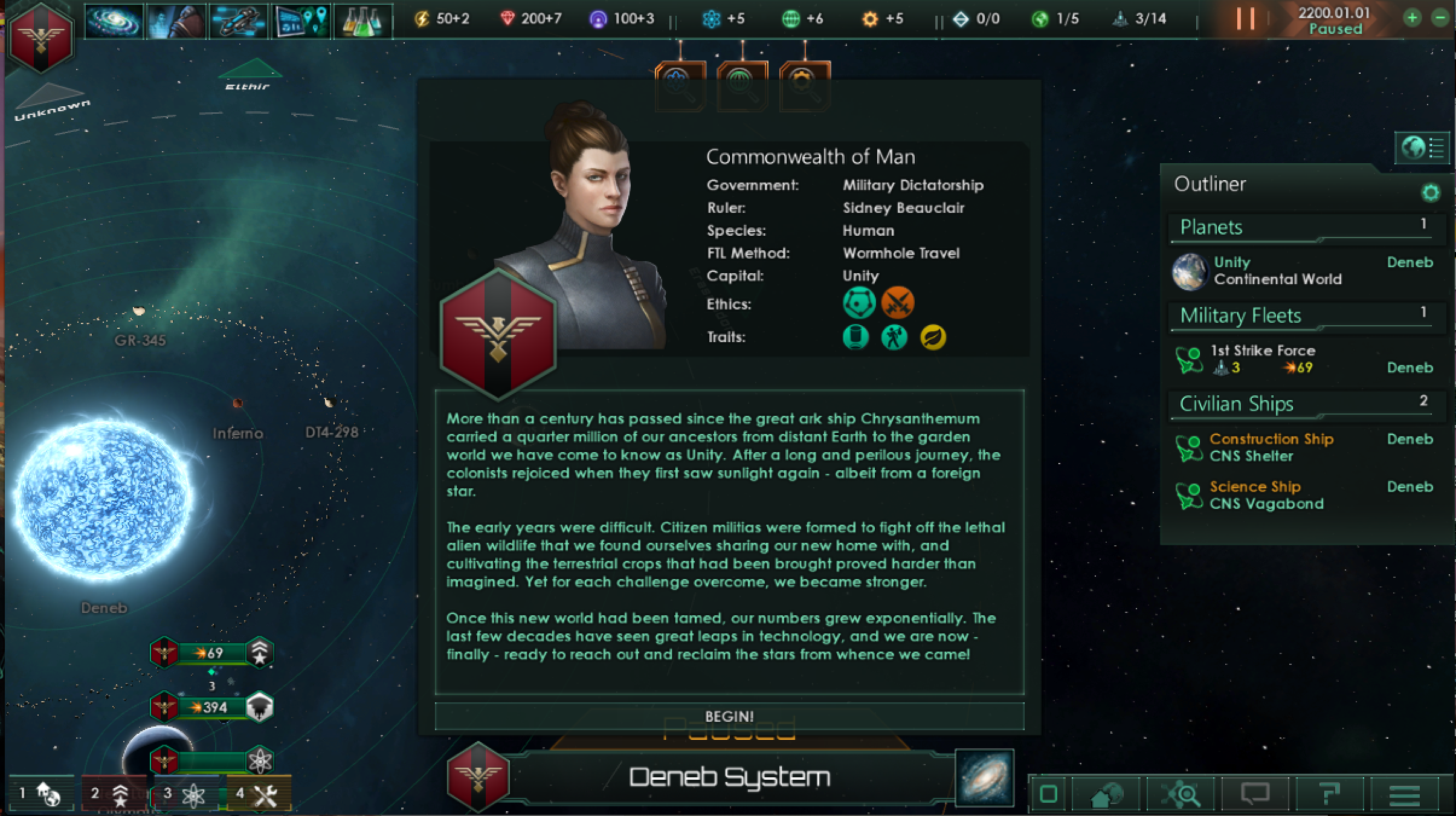
Above: See the Outliner menu at right? That’ll become your best friend during Stellaris gameplay.
And boy, does this game deliver pretty pictures
Watching and listening to Stellaris creates a joyous experience. Menus aren’t its only aspect that looks appealing: The star systems themselves to the tiles you control or the planets’ surfaces show the results of careful design and a smooth artistic touch, and I stopped plenty of times to just admire how something as simple as the “travel trails” showing a ship’s trajectory were built.
Space battles, while offering a little less control than I might have liked (more on that later), look awesome, every time. Tiny ships, darting everywhere, firing salvos of light — if you could picture holding the universe in your hands, each star a tiny pinprick of light, you’ve got a good idea of how Stellaris’ graphics and soaring soundtrack make you feel.
The music accompanying the view delivers a first-rate experience, and I often left the game running (but at menus, for fear of disaster — again, more on that in a second) while I did other things just to let it warble its orchestral and New Age white noise. During the far-too-infrequent combat sessions, I would have liked some marches or other more violent music-to-blow-things-up-by, but in general it offered a space-y vibe.

Above: Combat looks great up close like this — or from across the system. Also, blue lasers are definitely better than red ones.
In Stellaris, it pays to create your own race
So far, Stellaris has mostly hit the sweet spot between standard 4X gameplay and grand strategy. The action moves in real time, rather than in turns, so it gives you a sense of urgency and flow. You can control the speed that things move, but you won’t want to that often; speeding up the action means your to-do list piles up and can go south pretty quickly. It’s a testament to the pacing that you won’t want to all that often.
You start by choosing a faction from the six provided (a mix of human and avian and bug-like species with different governmental structures and technology) or by making your own. With other strategy games of this type, I would advise against making your own faction, as building your faction rapidly becomes tedious and makes little difference to the gameplay.
Not so in Stellaris. Here, the combinations of abilities, personality traits, and tech have a huge impact on how you play and evolve your budding society many hours down the road. Do you ally with other races, or do you conquer them or enslave them? What you choose on this screen will help decide.
Stellaris makes choosing characteristics for your new race a surprisingly fun process, and in the end, this feels a little like making a Sim: You have lots of buttons to push, the result is uniquely yours, and you’ll see it play out throughout the game. Skip the premade factions, and make your own.
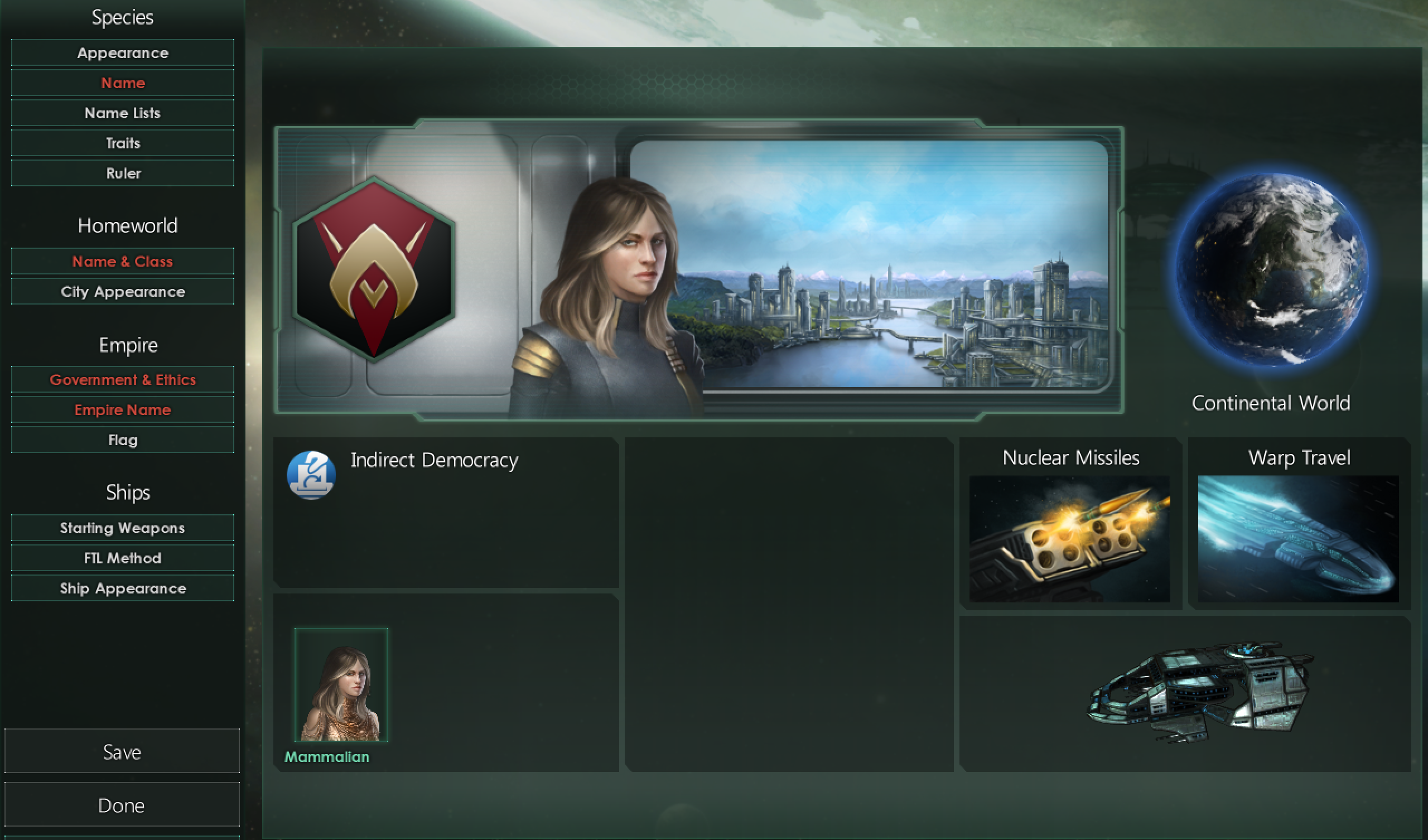
Above: This is absolutely where you should begin: Roll your own faction for far more fun.
Since when is exploration the fun part?
When you begin, you’ll explore your little solar system. You start with a couple of basic science and construction ships, and your job becomes finding the resources to make more, fast. A (honest to god) helpful tutorial guides you, but more than that, it offers little missions along the way that show you what to do but also give you additional decisions to make and things to consider.
As in Civilization V, these pop-up “quests” give you the chance to affect the overall trajectory of your gameplay — but they also provide fun diversions, giving you new and interesting things to do. And unlike Civ V, they usually mean you have to take some kind of action, not just click on menu choices.
I found the eXplore part of this 4X/grand strategy game the most consistently fun. New things to investigate, research, fight, or flee from popped up at a steady, truly pleasant rate, and while I always had plenty of things to do, I never felt overwhelmed. Each new planet my little science ships visited felt different than the one before, and the individual leaders I recruited (including named characters to direct some of those science ships) made a discernible difference to my gameplay.
The exploration piece of Stellaris made the steady, deliberate pace of resource acquisition bearable, and helped immensely with overcoming the “everybody’s building something, so now what?” stage of strategy games in general. I’m one of those folks who typically sets their scouts on auto-path and goes back to work on her cities. Not this time. My little science ships became my prized possessions, showing me the wonders of my tiny universe, and I loved them.
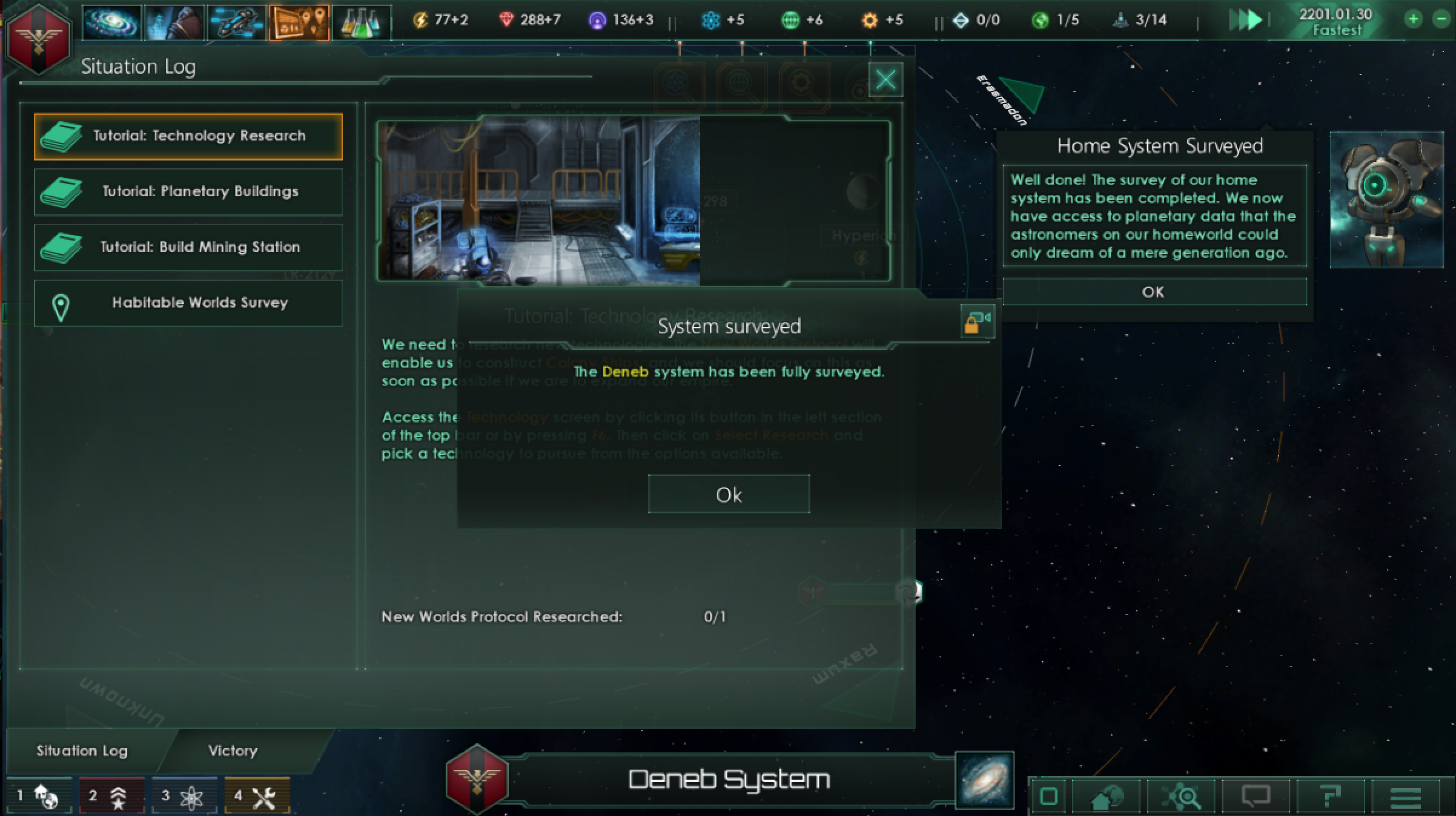
Above: Quests (at left) pop up throughout the game, not just during the tutorial. The pop-up “we’re done!” messages could use some work — some don’t offer enough information to tell you exactly what it was your little guys were doing.
Expansion feels natural, sophisticated and fun
As you settle in new parts of the galaxy, you have choices about what to do with the people you find there. Diplomacy isn’t necessarily Stellaris’s strong suit — as with combat, points decide everything, so you know exactly how many points of concessions you have to make to gain an advantage, in the same way you know how many types of attacks you need to win a battle. But some species aren’t that evolved, so you have the option to study them, or bring them into your empire and put them to work doing what they do best (hopefully, something your little “pops” don’t do well.)
Stellaris gives you hands-on control of just a limited number of settlements. After that, you’ll have to create sectors, putting your future in the hands of regional governors. I found the A.I. that ran these sectors to be uneven — they tend to turn out OK, but they’ll miss obvious opportunities.The system has some oddities as well, where you’ll have to build something on a planet, only to be told, “Thanks a million. We’ll take it from here,” as the sector wrests control away from you of what happens after that.
But the overall effect is to reduce the micromanagement to a manageable level, enabling you to focus on the more enjoyable exploration and new frontiers instead of remembering to upgrade that farm you built a dozen planets ago. People who get into grand strategy for that constant micropressure may not like the lack of autonomy, but I enjoyed the balance between tiny planetary actions and the ability to generally direct vast swaths of space with little effort.
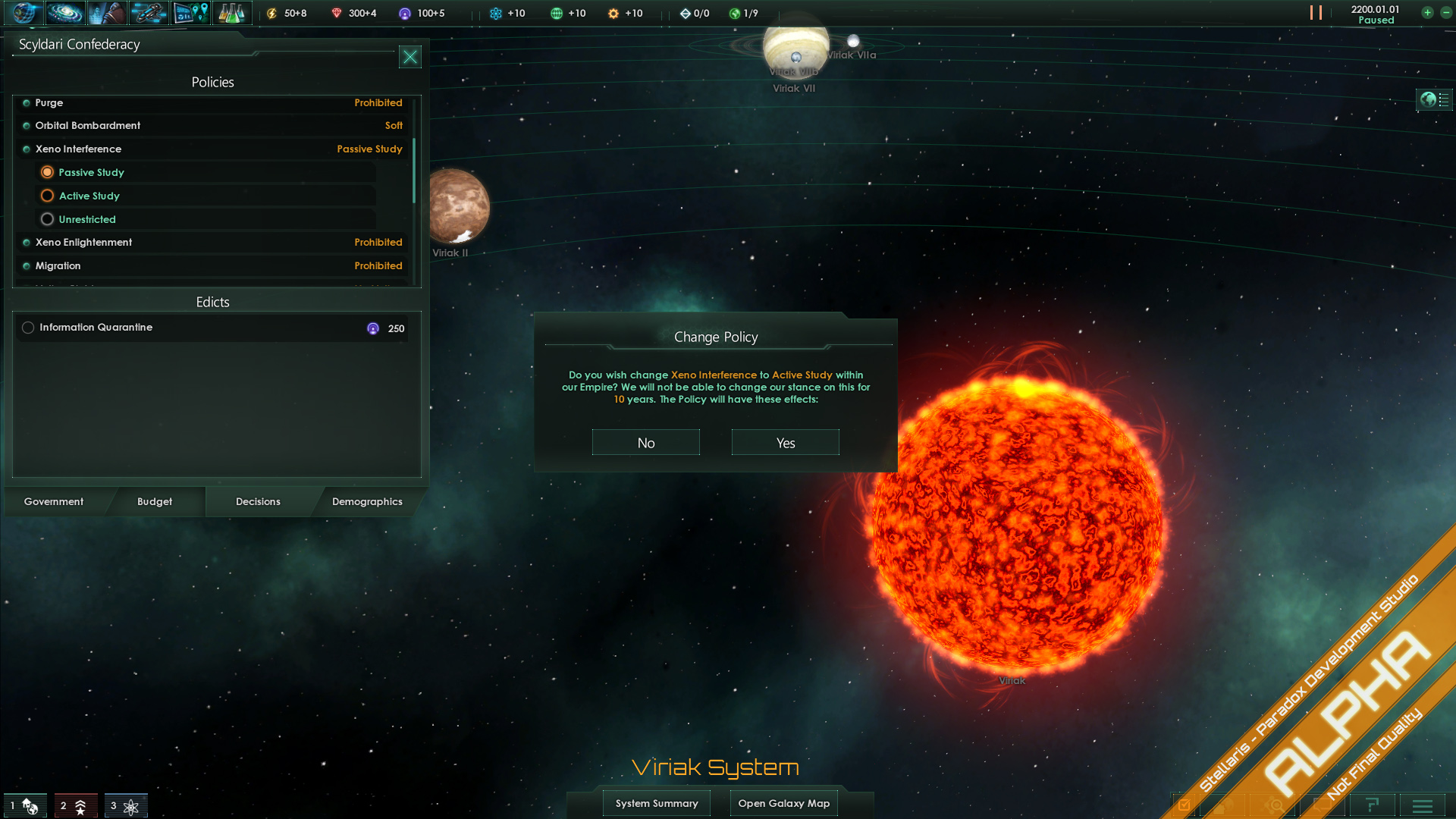
Above: Policies and edicts help keep your sectors in line, directing their overall production and research. (As shown in this screenshot from the Alpha.)
What you won’t like (so far)
OK, I saw everything. Now what?
An odd ennui takes over once you’ve explored the entirety of your little universe. Granted, it takes quite some time to actually overrun it (you must control 40 percent to win), but that becomes part of the problem. The pace of exploitation is slow, the other races in the universe don’t often attack or interfere, at least on Normal mode, and while there seems to be plenty to do, it tilts toward ongoing micromanagement rather than reacting to a series of issues.
If this were a SimCity game, right about now is when the A.I. would send giant spiders or alien invaders or sharknadoes.
Given the pace of development, I’m grateful Paradox didn’t often choose to randomly destroy my little civilizations. Revolts by one sector or another sometimes fill that role, taking away chunks of your progress when they decide fending for themselves would be more fun than working for you.
Don’t get me wrong; Stellaris hardly falls apart here. It still provides engrossing play, and your little universe still has plenty going on. But the “eXploit” section of Stellaris feels much less engaging than the eXploring and eXpanding, and the contrast surprised me.
Paradox hinted that in the endgame stage, Stellaris would throw some surprises my way — robot revolutions, for example. But perhaps because my little faction didn’t choose in many cases to convert its people armies to robot masses, or perhaps because I didn’t play through to the final win or loss enough times, those experiences were disappointingly infrequent.
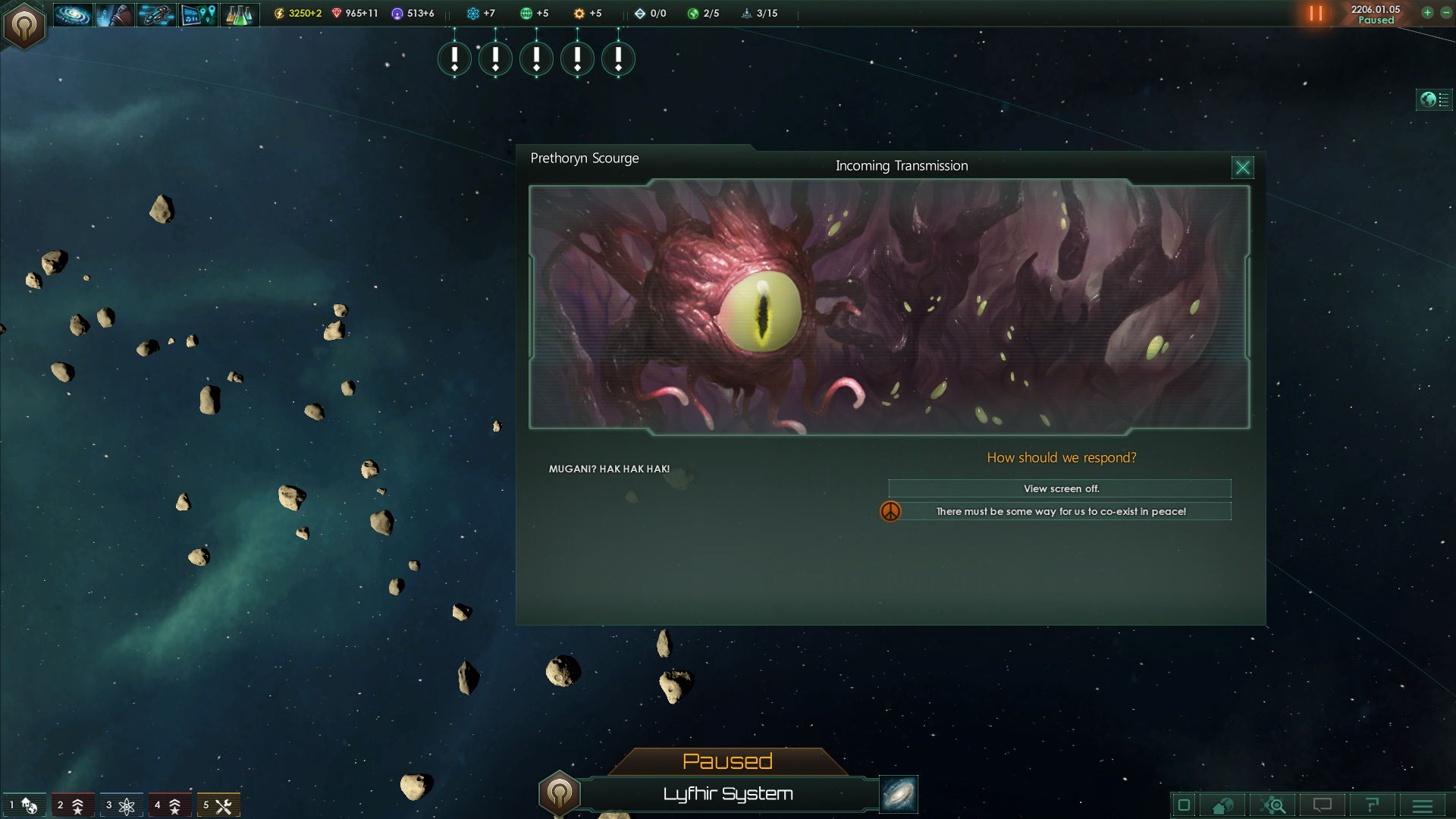
Above: Stellaris’ apparent answer to giant mutant spiders: angry eyeball monsters.
Combat seems optional and uninspired
As noted above, Stellaris’s combat looks amazing. I sometimes attacked other races just for the fun of seeing all those little ships in action. But that might be part of the problem: In order to see combat, I frequently had to be the one initiating it.
It might be that the Normal difficulty needs to be tuned up (or changed to Peaceful or Easy instead, perhaps) to make other races more hostile. Right now, difficulty settings give aliens bonuses to research and economy and make them less likely to ally with you — not, apparently, more likely to attack.
Hey, I’m not that bloodthirsty. I just like a little more “eXterminate” in my space strategy, if you know what I mean. And it would be nice, if I wanted to win by conquering everyone, if sometimes they hit first.
Once combat actually gets underway, I would appreciate more control. Ground battles grind out via auto-combat by default, and even in space battles, my ability to use actual strategy to protect and flank and distract felt limited, at least with default controls. But the fighting still satisfied, so again, this complaint felt minor.
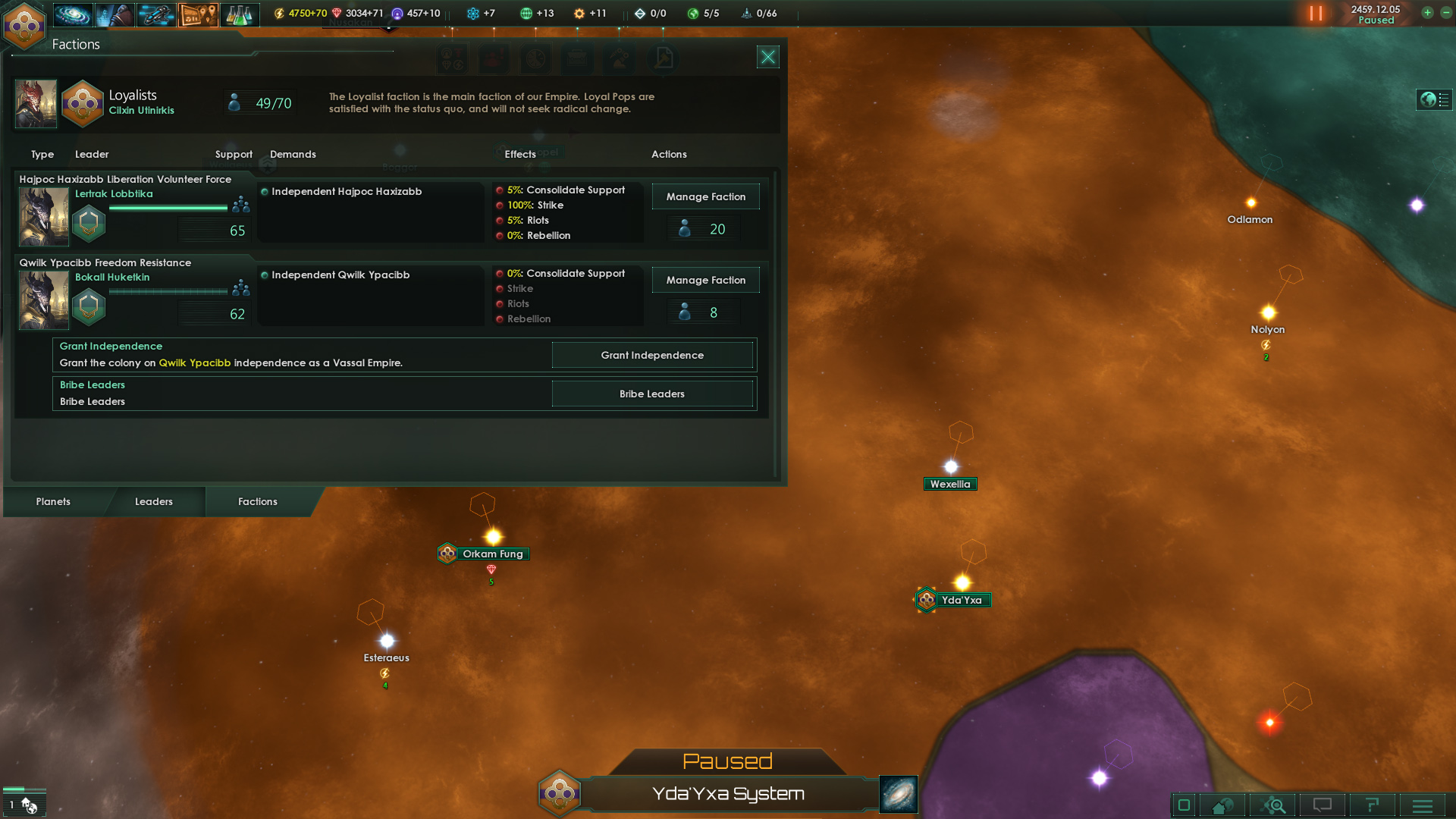
Above: Then again, one of your sectors could helpfully develop factions and break off to become independent and in need of attacking. You can always hope.
Real-time integration sometimes stuttered — as did the game
Most games like Stellaris choose to make the action turn-based for a reason. Grand strategy typically requires grand thought, and it’s difficult to do that effectively while your ships stream toward a destination. The “strategy” in real-time strategy games tends to be more limited, centering around a particular attack rather than the overarching goals of the game.
Stellaris has just two goals: control more than 40 percent of your universe, or conquer all alien races, which also felt a bit oddly limiting.
For the most part, the real-time nature of Stellaris worked well, but sometimes I would have appreciated the opportunity to have regular pauses in which to evaluate and consider. And heaven help you if you forgot and walked away while it was running after accidentally unpausing. I did that twice, both with games in the early stages, and both times had to abandon ship.
Stellaris also suffered from a few very minor technical issues. Performance during huge space battles slowed, and occasional bugs made me lift an eyebrow — but nothing seriously affected the gameplay.
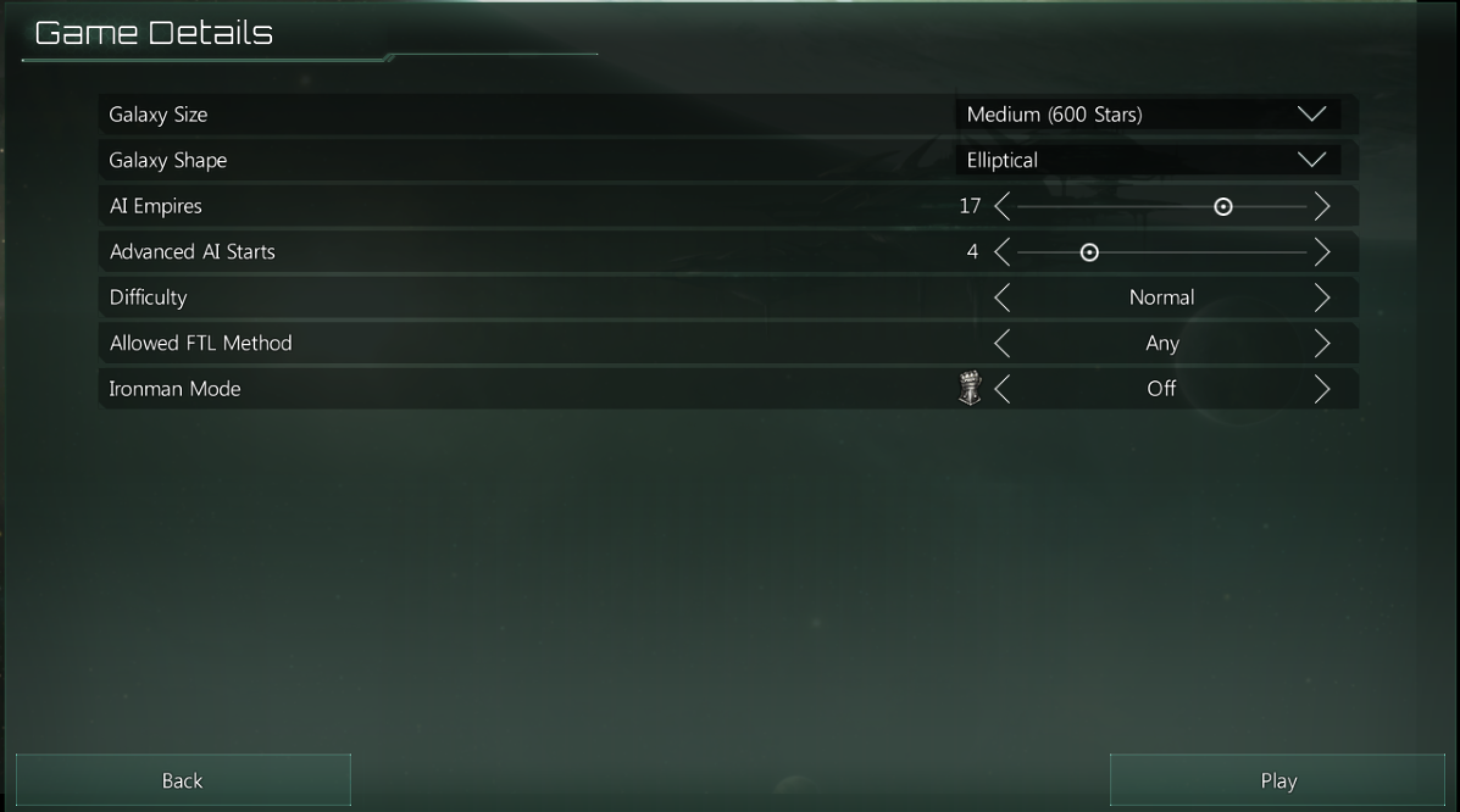
Above: Difficulty options don’t offer too many knobs to turn. “Ironman mode” disables custom saves, using a single autosave as you go so you can’t turn back.
Tech integration depends too much on RNG
When I started playing Stellaris, the research and technology system delighted me. Instead of a tree, it presented three options of what to choose next, giving me random progression as the game moved on. It made each game feel unique, and I appreciated the random “epic” tech that popped up, its welcome purple design inviting me to snatch it up.
You also have three types of tech to explore simultaneously in Stellaris: physics, society and engineering. That, too, felt like a lot of fun. You didn’t have to choose which direction to take your race; you could learn everything at once.
But there were too many times when I neared the end of a shorter game and discovered that one facet or another of my research was vastly behind, in part due to bad RNG for drawing that tech’s advances in my random three options. Truly, you could play through some games without ever noticing the problem; but when it happened, it irritated me.
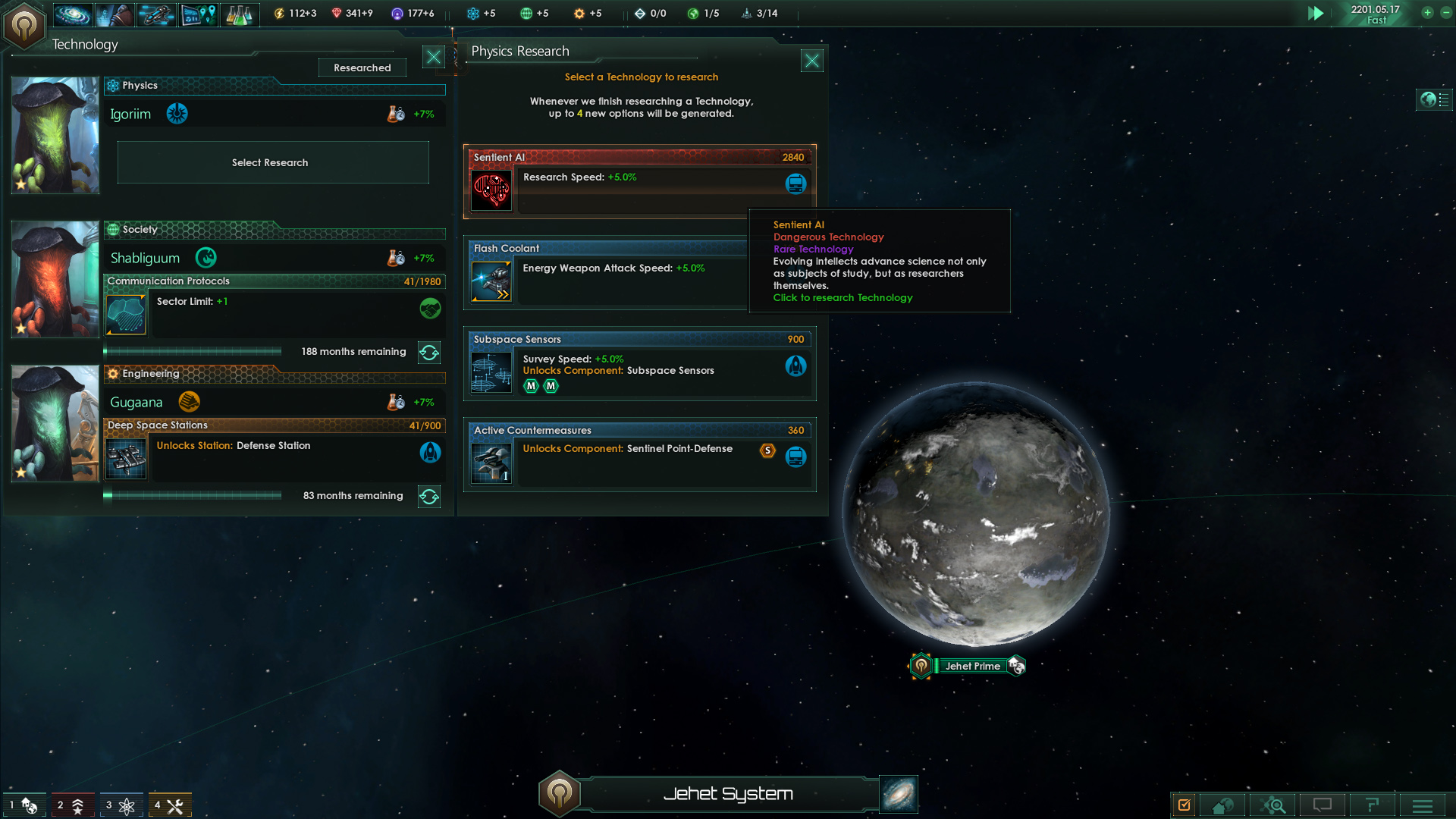
Above: Stellaris helpfully tells you that building sentient robots may not be the best idea. But no, you go ahead and build SkyNet. It’s fine.
Conclusion (so far)
Based on single-player action alone, Stellaris takes a place among the best space-based strategy games on the market. Its combination of real-time action, 4X structure and grand strategy aspirations makes possibly the best mashup I’ve ever seen of those genres, and that’s saying something. Yes, I had some quibbles about the intermediate stages of the game, and yes, it made the occasional misstep in how much control it chose to give me.
But overall, Stellaris wows, not just with the gameplay, but in the tiny details that make it so freaking enjoyable to play. Kudos to Paradox for the overall design and feel of this game; it felt as if they put a team of user experience analysts on the case.
Given how strategy games tend to evolve as they move along, I’m looking forward to expansions — or mods, which have some incredible possibilities here — that resolve some of my issues and add some extra victory conditions. But even without them, Stellaris puts the galaxy in your hands in a way that every once in a while feels magical.
Again, I’ll be updating this review after having had the chance to give multiplayer a good test.
Stellaris won’t expand strategy to a mass audience; while more accessible, it won’t appeal to people who like building things in reality rather than in concept. But if you’re like me, on the fence between 4X and grand strategy titles, you’ll enjoy the heck out of the single-player campaign.
Score: TBD
Stellaris is out now for PC and Mac. The publisher provided GamesBeat with a Steam code for the purposes of this review.
VentureBeat's mission is to be a digital town square for technical decision-makers to gain knowledge about transformative enterprise technology and transact. Learn More
